|
S,S-dimethyl-β-propiothetin
Dimethylsulfoniopropionate (DMSP), is an organosulfur compound with the formula (CH3)2S+CH2CH2COO−. This zwitterionic metabolite can be found in marine phytoplankton, seaweeds, and some species of terrestrial and aquatic vascular plants. It functions as an osmolyte as well as several other physiological and environmental roles have also been identified. DMSP was first identified in the marine red alga ''Polysiphonia fastigiata''. Biosynthesis In higher plants, DMSP is biosynthesized from ''S''-methylmethionine. Two intermediates in this conversion are dimethylsulfoniumpropylamine and dimethylsulfoniumpropionaldehyde. In algae, however, the biosynthesis starts with the replacement of the amino group in methionine by hydroxide. Degradation DMSP is broken down by marine microbes to form two major volatile sulfur products, each with distinct effects on the environment. One of its breakdown products is methanethiol (CH3SH), which is assimilated by bacteria into protein sulfur. ... [...More Info...] [...Related Items...] OR: [Wikipedia] [Google] [Baidu] |
DMSP-lyase
The enzyme dimethylpropiothetin dethiomethylase (EC 4.4.1.3) catalyzes the chemical reaction :''S,S''-dimethyl-β-propiothetin \rightleftharpoons dimethyl sulfide + acrylate The enzyme breaks ''S,S''-dimethyl-β-propiothetin into dimethyl sulfide and acrylate. This enzyme belongs to the family of lyases, specifically the class of carbon-sulfur lyases. The systematic name A systematic name is a name given in a systematic way to one unique group, organism, object or chemical substance, out of a specific population or collection. Systematic names are usually part of a nomenclature. A semisystematic name or semitrivi ... of this enzyme class is ''S,S''-dimethyl-β-propiothetin dimethyl-sulfide-lyase (acrylate-forming). Other names in common use include desulfhydrase, and ''S,S''-dimethyl-beta-propiothetin dimethyl-sulfide-lyase. References * EC 4.4.1 Enzymes of unknown structure {{lyase-stub ... [...More Info...] [...Related Items...] OR: [Wikipedia] [Google] [Baidu] |
Marine Bacteria
Marine prokaryotes are marine bacteria and marine archaea. They are defined by their habitat as prokaryotes that live in marine environments, that is, in the saltwater of seas or oceans or the brackish water of coastal estuaries. All cellular life forms can be divided into prokaryotes and eukaryotes. Eukaryotes are organisms whose cells have a nucleus enclosed within membranes, whereas prokaryotes are the organisms that do not have a nucleus enclosed within a membrane. The three-domain system of classifying life adds another division: the prokaryotes are divided into two domains of life, the microscopic bacteria and the microscopic archaea, while everything else, the eukaryotes, become the third domain. Prokaryotes play important roles in ecosystems as decomposers recycling nutrients. Some prokaryotes are pathogenic, causing disease and even death in plants and animals. Marine prokaryotes are responsible for significant levels of the photosynthesis that occurs in the oce ... [...More Info...] [...Related Items...] OR: [Wikipedia] [Google] [Baidu] |
Coccolithophore
Coccolithophores, or coccolithophorids, are single-celled organisms which are part of the phytoplankton, the autotrophic (self-feeding) component of the plankton community. They form a group of about 200 species, and belong either to the kingdom Protista, according to Robert Whittaker (ecologist), Robert Whittaker's five-kingdom system, or clade Hacrobia, according to a newer biological classification system. Within the Hacrobia, the coccolithophores are in the phylum or division (botany), division Haptophyta, class Prymnesiophyceae (or Coccolithophyceae). Coccolithophores are almost exclusively Marine (ocean), marine, are photosynthesis, photosynthetic and mixotrophic, and exist in large numbers throughout the Photic zone, sunlight zone of the ocean. Coccolithophores are the most productive calcifying organisms on the planet, covering themselves with a calcium carbonate shell called a ''coccosphere''. However, the reasons they calcify remain elusive. One key function may be that ... [...More Info...] [...Related Items...] OR: [Wikipedia] [Google] [Baidu] |
CLAW Hypothesis
The CLAW hypothesis proposes a negative feedback loop that operates between ocean ecosystems and the Earth's climate. The hypothesis specifically proposes that particular phytoplankton that produce dimethyl sulfide are responsive to variations in climate forcing, and that these responses act to stabilise the temperature of the Earth's atmosphere. The CLAW hypothesis was originally proposed by Robert Jay Charlson, James Lovelock, Meinrat Andreae and Stephen G. Warren, and takes its acronym from the first letter of their surnames. CLAW hypothesis The hypothesis describes a feedback loop that begins with an increase in the available energy from the sun acting to increase the growth rates of phytoplankton by either a physiological effect (due to elevated temperature) or enhanced photosynthesis (due to increased irradiance). Certain phytoplankton, such as coccolithophorids, synthesise dimethylsulfoniopropionate (DMSP), and their enhanced growth increases the production of thi ... [...More Info...] [...Related Items...] OR: [Wikipedia] [Google] [Baidu] |
Acrylate
Acrylates (IUPAC: prop-2-enoates) are the salts, esters, and conjugate bases of acrylic acid. The acrylate ion is the anion . Often, acrylate refers to esters of acrylic acid, the most common member being methyl acrylate. These acrylates contain vinyl groups. These compounds are of interest because they are bifunctional: the vinyl group is susceptible to polymerization and the carboxylate group carries myriad functionalities. Monomers Acrylates are defined by the formula , where R can be many groups: * Acrylic acid * Methyl acrylate * Ethyl acrylate * 2-Chloroethyl vinyl ether * 2-Ethylhexyl acrylate * Butyl acrylate * Trimethylolpropane triacrylate (TMPTA) The versatility of the resulting polymers is owed to the range of R groups. File:Acrylate-anion.svg, The acrylate anion File:Trimethylolpropane triacrylate.svg, Trimethylolpropane triacrylate (TMPTA), a trifunctional acrylate ester File:Methylacrylat.svg, Methyl acrylate, an acrylic ester File:Hexandioldiacrylat.svg ... [...More Info...] [...Related Items...] OR: [Wikipedia] [Google] [Baidu] |
Seafood Products
Seafood is any form of Marine life, sea life regarded as food by humans, prominently including Fish as food, fish and shellfish. Shellfish include various species of Mollusca, molluscs (e.g., bivalve molluscs such as clams, oysters, and mussels, and cephalopods such as octopus and squid), crustaceans (e.g. shrimp, crabs, and lobster), and echinoderms (e.g. sea cucumbers and sea urchins). Historically, marine mammals such as cetaceans (whales and dolphins) as well as Pinniped, seals have been eaten as food, though that happens to a lesser extent in modern times. Edible sea plants such as some Edible seaweed, seaweeds and microalgae are widely eaten as :edible seaweeds, sea vegetables around the world, especially in Asia. Seafood is an important source of (animal) protein in many Diet (nutrition), diets around the world, especially in coastal areas. Semi-vegetarianism, Semi-vegetarians who consume seafood as the only source of meat are said to adhere to pescetarianism. The harv ... [...More Info...] [...Related Items...] OR: [Wikipedia] [Google] [Baidu] |
Filter Feeder
Filter feeders are aquatic animals that acquire nutrients by feeding on organic matters, food particles or smaller organisms (bacteria, microalgae and zooplanktons) suspended in water, typically by having the water pass over or through a specialized filtering organ that sieves out and/or traps solids. Filter feeders can play an important role in condensing biomass and removing excess nutrients (such as nitrogen and phosphate) from the local waterbody, and are therefore considered water-cleaning ecosystem engineers. They are also important in bioaccumulation and, as a result, as indicator organisms. Filter feeders can be sessile, planktonic, nektonic or even neustonic (in the case of the buoy barnacle) depending on the species and the niches they have evolved to occupy. Extant species that rely on such method of feeding encompass numerous phyla, including poriferans ( sponges), cnidarians (jellyfish, sea pens and corals), arthropods ( krill, mysids and barna ... [...More Info...] [...Related Items...] OR: [Wikipedia] [Google] [Baidu] |
Herbivory
A herbivore is an animal anatomically and physiologically evolved to feed on plants, especially upon vascular tissues such as foliage, fruits or seeds, as the main component of its diet. These more broadly also encompass animals that eat non-vascular autotrophs such as mosses, algae and lichens, but do not include those feeding on decomposed plant matters (i.e. detritivores) or macrofungi (i.e. fungivores). As a result of their plant-based diet, herbivorous animals typically have mouth structures ( jaws or mouthparts) well adapted to mechanically break down plant materials, and their digestive systems have special enzymes (e.g. amylase and cellulase) to digest polysaccharides. Grazing herbivores such as horses and cattles have wide flat- crowned teeth that are better adapted for grinding grass, tree bark and other tougher lignin-containing materials, and many of them evolved rumination or cecotropic behaviors to better extract nutrients from plants. A large perce ... [...More Info...] [...Related Items...] OR: [Wikipedia] [Google] [Baidu] |
Hygroscopy
Hygroscopy is the phenomenon of attracting and holding water molecules via either absorption or adsorption from the surrounding environment, which is usually at normal or room temperature. If water molecules become suspended among the substance's molecules, adsorbing substances can become physically changed, e.g. changing in volume, boiling point, viscosity or some other physical characteristic or property of the substance. For example, a finely dispersed hygroscopic powder, such as a salt, may become clumpy over time due to collection of moisture from the surrounding environment. ''Deliquescent'' materials are sufficiently hygroscopic that they dissolve in the water they absorb, forming an aqueous solution. Hygroscopy is essential for many plant and animal species' attainment of hydration, nutrition, reproduction and/or seed dispersal. Biological evolution created hygroscopic solutions for water harvesting, filament tensile strength, bonding and passive motion – natural so ... [...More Info...] [...Related Items...] OR: [Wikipedia] [Google] [Baidu] |
Solar Radiation
Sunlight is the portion of the electromagnetic radiation which is emitted by the Sun (i.e. solar radiation) and received by the Earth, in particular the visible light perceptible to the human eye as well as invisible infrared (typically perceived by humans as warmth) and ultraviolet (which can have physiological effects such as sunburn) lights. However, according to the American Meteorological Society, there are "conflicting conventions as to whether all three ..are referred to as light, or whether that term should only be applied to the visible portion of the spectrum." Upon reaching the Earth, sunlight is scattered and filtered through the Earth's atmosphere as daylight when the Sun is above the horizon. When direct solar radiation is not blocked by clouds, it is experienced as sunshine, a combination of bright light and radiant heat (atmospheric). When blocked by clouds or reflected off other objects, sunlight is diffused. Sources estimate a global average o ... [...More Info...] [...Related Items...] OR: [Wikipedia] [Google] [Baidu] |
Global Climate
Climate is the long-term weather pattern in a region, typically averaged over 30 years. More rigorously, it is the mean and Statistical dispersion, variability of Meteorology, meteorological variables over a time spanning from months to millions of years. Some of the Meteorology, meteorological variables that are commonly measured are temperature, humidity, atmospheric pressure, wind, and precipitation. In a broader sense, climate is the state of the components of the climate system, including the atmosphere, hydrosphere, cryosphere, lithosphere and biosphere and the interactions between them. The climate of a location is affected by its latitude, longitude, terrain, altitude, land use and nearby body of water, water bodies and their currents. Climates can be Climate classification, classified according to the average and typical variables, most commonly temperature and precipitation. The most widely used classification scheme is the Köppen climate classification. The Thornth ... [...More Info...] [...Related Items...] OR: [Wikipedia] [Google] [Baidu] |
Dimethyl Sulfoxide
Dimethyl sulfoxide (DMSO) is an organosulfur compound with the formula . This colorless liquid is the sulfoxide most widely used commercially. It is an important polar aprotic solvent that dissolves both polar and nonpolar compounds and is miscible in a wide range of organic solvents as well as water. It has a relatively high boiling point. DMSO is metabolised to compounds that leave a garlic-like taste in the mouth after DMSO is absorbed by skin. In terms of chemical structure, the molecule has idealized Cs symmetry. It has a trigonal pyramidal molecular geometry consistent with other three-coordinate S(IV) compounds, with a nonbonded electron pair on the approximately tetrahedral sulfur atom. Synthesis and production Dimethyl sulfoxide was first synthesized in 1866 by the Russian scientist Alexander Zaytsev, who reported his findings in 1867. Its modern use as an industrial solvent began through popularization by Thor Smedslund at the Stepan Chemical Company. Dimeth ... [...More Info...] [...Related Items...] OR: [Wikipedia] [Google] [Baidu] |







